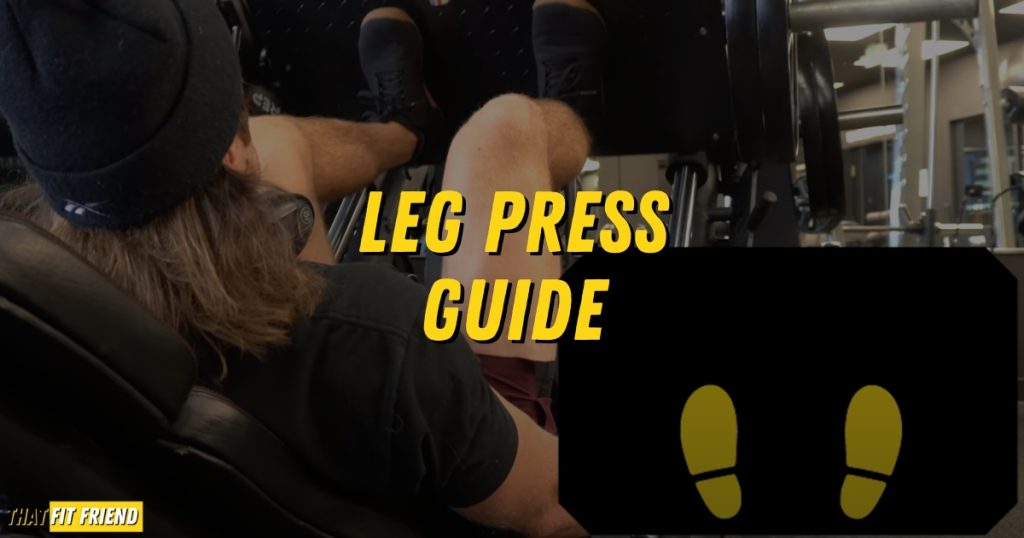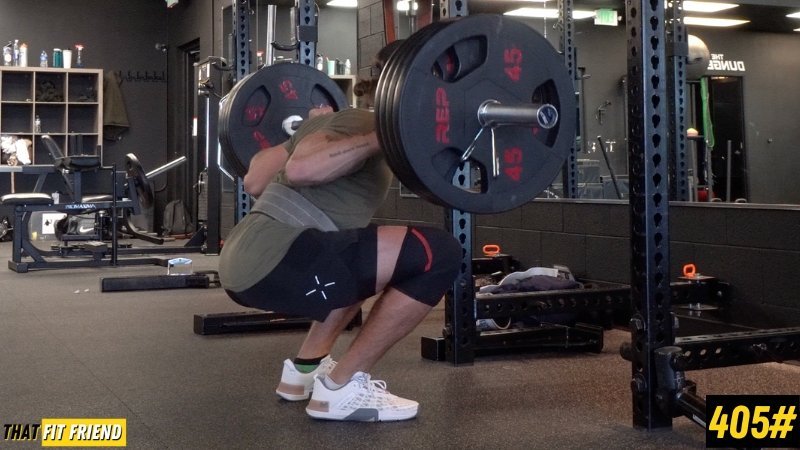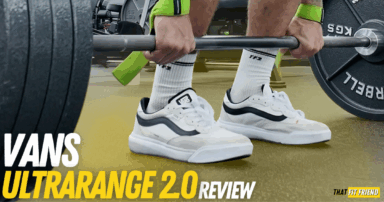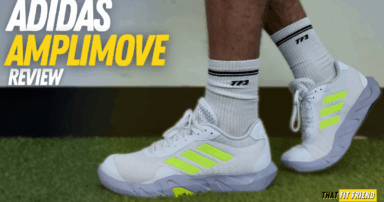The leg press is what I consider a staple exercise when it comes to building leg strength and mass. There are countless ways to program the leg press based on your training goals.
I like to use the leg press for myself and my clients by focusing on different muscle groups based on what we’re trying to accomplish. For example, programming leg presses for quads, glutes, and adductors.
The leg press is an awesome exercise for building overall strength and mass. If you have specific muscle-building goals, then you can bias your leg press to target the quads, glutes, and adductors by tweaking your foot position.
Leg Press Foot Placement
One of my favorite things about the leg press is how your foot placement can manipulate your outcomes. For example, by shifting your feet around you can bias different muscle groups which is awesome for hypertrophy.
How to Leg Press for Quads
If your goal is crushing the quads with the leg press, then you’ll want to bring your feet closer together and down a little bit on the platform. Now, this can vary depending on your anatomy and leg press machine, but the above is typically a good starting point.
Essentially, if we’re wanting to hit the quads more heavily with the leg press then we want the knees to track further over the toes when doing reps.
- To leg press for quads, bring your feet down on the platform and bring them around hip to shoulder width apart
By bringing the feet down and a little more parallel we can focus on stretching the quads more which can lead to a better hypertrophy stimulus when leg pressing.
If you find that you lack the mobility to keep the heel down while trying to leg press for quads, then I’d highly suggest using a heel wedge or wearing your weightlifting shoes for your quad-biased sets.
The elevated heel can help the feed more into forward knee translation so it’s a nice way to still get a quad stimulus without spending a ton of time doing “mobility work” which may or may not have a positive carryover in this context.
How to Leg Press for Glutes
When it comes to your foot placement for targeting the glutes with the leg press the name of the game is how you’re stretching the glute max.
For glutes, you’ll want to keep your feet relatively parallel, bring them on the platform, and keep them hip to shoulder width apart.
- To leg press for glutes, keep your feet around hip-width apart and slide up on your leg press platform.
By bringing the feet up on the leg press platform, we can focus on getting more stretch for our glute max. This in turn will create a glute bias when performing leg press reps.
It might feel like you’re not working with a large range of motion when leg pressing for the glutes, but remember, for this context, we’re after a specific range of motion for the targeted muscles (the glutes) and more is not necessarily more here.
If you find that your hips keep lifting off of your leg press seat while leg pressing for glutes, then try setting a foam pad in the seat. This elevation may be enough to put you into a better position if your leg press seat is really deep.
How to Leg Press for Adductors
If your goal is building beefy adductors with the leg press, then you’ll want to bring your feet out wider than your traditional setup and then turn your toes out slightly.
By bringing the feet out wider, you can typically get a deeper range of motion regarding your peak hip flexion and with the toes out you can clear the knees easier to let the adductors take over and do their thing at the end range of motion.
- To leg press for adductors, keep your feet around hip to shoulder-width apart and turn your toes out slightly.
The adductors will be most active towards the end of the range of motion with leg presses for adductors, and for this variation, I’d suggest trying to get as much range of motion as possible without compensating your form or losing contact with your leg press seat.
Keep in mind, that you don’t need to go “sumo squat” width with these. Generally, if you bring the feet out slightly while turning the toes out you’ll actually get more range of motion than going with the maximal width of the leg press platform.
However, this can be highly individualized based on your leg press machine, hip mobility, and anatomy, so don’t be afraid to play around with your foot placement as you add these into your training blocks.
How To Leg Press
Step 1: Brace and Set the Feet
The first step is bracing into your leg press’s seat correctly. To do this properly, make sure your hips are flush with both pads of the seat and grip the handles for additional support.
To set the feet, place them hip to shoulder-width apart and keep your shoes flat on the leg press. You may need to play with your positioning based on your leg press.
Step 2: Drive Through the Platform Equally With the Feet
Once you’ve nailed your setup, press and extend the legs and unlock your leg press. From here, take a second or two to ensure your setup is solid and you feel comfortable before starting your reps.
Step 3: Lower the Weight In a Controlled Means
Lower the weight to yourself with a controlled tempo. Ideally, you want your feet to remain flat on the leg press platform through the entire range of motion and you want your hips to remain flush with the seat.
If your heels are coming off the platform as you lower the weight, then bring your feet up on the platform. If the hips are coming off of the seat, then limit your range of motion or place a foam pad in the seat as this can help with your positioning.
Step 4: Press, Squeeze, and Repeat
Once you’ve hit your end range of motion, press away the leg press platform thinking about keeping a balanced level of force through the entire foot.
At the top of your press, squeeze the quads without rushing or overextending the legs. This should be a controlled and strong contraction. Your quad squeeze is your signal to start your next rep.
Why Perform Them
There’s a good reason the leg press is a staple in most workout programs. Below are three of my favorite leg press benefits that are worth keeping in mind when programming this exercise.
1. Great for Different Types of Goals
My favorite leg press benefit is that this exercise is very versatile. When most lifters think about the leg press, they think about a singular way of performing and using it.
Contrary to the norm, the leg press can be as dynamic as want it to be. For example, you can use the leg press to tackle all types of adaptations and training goals like increasing strength, leg hypertrophy, and power.
On top of this, you can alter your leg press mechanics to bias different muscle groups like the quads, adductors, and glutes based on your leg press foot placement. Factor in this specificity with the adaptations above and you have a really dynamic exercise for tackling different goals.
As an added perk, the leg press is an exercise that lifters of all skill levels can perform and utilize. Beginners and experienced lifters can use the leg press to experience awesome gains in the gym.
2. Can Be Pushed Heavy While Limiting Overall Fatigue
Barbell squat variations are awesome for building strength, but they can be pretty fatiguing depending on your volume and intensities. Compared to its barbell counterparts, the leg press can be less fatiguing when taken heavily.
Whether you’re run down from life, a tough training cycle, or your sport, the leg press can be a great exercise for keeping your training stimulus high while mitigating overall fatigue.
One way I like to use the leg press to keep my training stimulus high while limiting fatigue is to use heavier sets with a limited range of motion. This gives my nervous system exposure to heavier loads while not killing myself with a lot of volume and range of motion.
If you’re wanting to experiment with leg presses in the context of fatigue mitigation, then I’d suggest trying out different sets, reps, and intensity schemes to see what you respond best to.
3. Awesome for Working Around Injuries
Another lesser-talked-about leg press benefit is that it can be a viable exercise for working around injuries. More specifically, if you’re working around an injury that hinders you from doing things like back and front squats, then a leg press can be a good option to explore.
I’ll typically explore the leg press for athletes and lifters that may not be able to squat due to a back injury or lower-body injury that requires a little more stabilization.
The leg press gives us a lot of constraints. It doesn’t load the back, it’s easy to manipulate foot position based on what feels best, and you can adjust your range of motion seamlessly toward what you can handle.
If you’re wanting to push your legs and the intensity at which you’re training them and you’re currently limited by an injury, then the leg press can be a suitable leg exercise to explore.
Muscles Trained
The leg press is great because you can set up and execute your reps to target and bias different muscle groups. Below I’ll cover what muscles the traditional leg press works. Note, different leg press machines can impact “how much” certain muscles are worked.
If you’re wanting to bias different muscle groups with the leg press, I’ll cover how to do so in the foot placement section below.
Can Leg Press Replace Squats?
A question that receives a lot of attention and debate in the fitness industry is, “Can leg press replace squats?” A lot of lifters will look at this question from a black-and-white viewpoint and simply say yes or no, but that’s not the most productive approach.
Instead of simply rattling off a yes or no, I think it’s more useful to ask a follow-up question, “What are your goals?”
If your goal is building your squat specifically, then no, a leg press can’t replace squats. A squat, like a fine-tuned golf swing, is a skill that needs to be practiced, and if you want to get good at squats, then you need to squat.
To add to this, if you compete in strength sports like powerlifting or ever want to compete in strength sports, then you’ll need to squat and improve your strength with this lift.
Now that said, and this is where the gray area of this question resides, if you’re not worried about building your barbell squat or you don’t care to, then you can use leg press to build lower body strength just fine without squatting.
The leg press can be an awesome substitute for a squat for overloading your legs and giving you a high training stimulus, especially for recreational lifters wanting to build general lower body strength with no squat-specific goals.
Plus, if you’re following a well-rounded program that includes things like split squats, lunges, and other lower body accessories then you’ll be covering pretty much all of your bases regarding the ranges of motion you’re strengthening and working through.
Takeaway Thoughts
In my coaching opinion, the leg press doesn’t receive enough credit regarding its versatility. This exercise can be great for building lower body strength for lifters from all walks of life.
The leg press is also awesome for building the glutes, quads, and adductors depending on your foot placement and how you’re executing your reps.
If you’ve never performed leg presses for different muscle groups, I’d highly suggest giving them a try for a few blocks and playing with your form while tracking positive training outcomes.
If you have additional questions about the leg press, drop a comment below or reach out to me personally via Instagram (@jake_boly or @that_fit_friend).
























Add a Comment